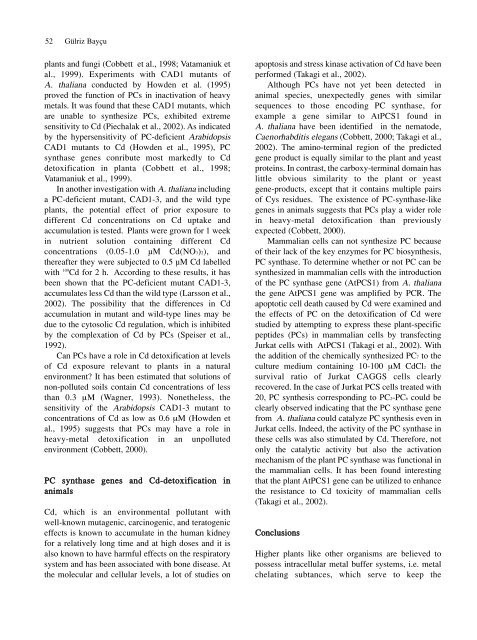Full Journal - Journal of Cell and Molecular Biology - Haliç Üniversitesi
Full Journal - Journal of Cell and Molecular Biology - Haliç Üniversitesi
Full Journal - Journal of Cell and Molecular Biology - Haliç Üniversitesi
Create successful ePaper yourself
Turn your PDF publications into a flip-book with our unique Google optimized e-Paper software.
52 Gülriz Bayçu<br />
plants <strong>and</strong> fungi (Cobbett et al., 1998; Vatamaniuk et<br />
al., 1999). Experiments with CAD1 mutants <strong>of</strong><br />
A. thaliana conducted by Howden et al. (1995)<br />
proved the function <strong>of</strong> PCs in inactivation <strong>of</strong> heavy<br />
metals. It was found that these CAD1 mutants, which<br />
are unable to synthesize PCs, exhibited extreme<br />
sensitivity to Cd (Piechalak et al., 2002). As indicated<br />
by the hypersensitivity <strong>of</strong> PC-deficient Arabidopsis<br />
CAD1 mutants to Cd (Howden et al., 1995), PC<br />
synthase genes conribute most markedly to Cd<br />
detoxification in planta (Cobbett et al., 1998;<br />
Vatamaniuk et al., 1999).<br />
In another investigation with A. thaliana including<br />
a PC-deficient mutant, CAD1-3, <strong>and</strong> the wild type<br />
plants, the potential effect <strong>of</strong> prior exposure to<br />
different Cd concentrations on Cd uptake <strong>and</strong><br />
accumulation is tested. Plants were grown for 1 week<br />
in nutrient solution containing different Cd<br />
concentrations (0.05-1.0 µM Cd(NO3)2), <strong>and</strong><br />
thereafter they were subjected to 0.5 µM Cd labelled<br />
with 109 Cd for 2 h. According to these results, it has<br />
been shown that the PC-deficient mutant CAD1-3,<br />
accumulates less Cd than the wild type (Larsson et al.,<br />
2002). The possibility that the differences in Cd<br />
accumulation in mutant <strong>and</strong> wild-type lines may be<br />
due to the cytosolic Cd regulation, which is inhibited<br />
by the complexation <strong>of</strong> Cd by PCs (Speiser et al.,<br />
1992).<br />
Can PCs have a role in Cd detoxification at levels<br />
<strong>of</strong> Cd exposure relevant to plants in a natural<br />
environment? It has been estimated that solutions <strong>of</strong><br />
non-polluted soils contain Cd concentrations <strong>of</strong> less<br />
than 0.3 µM (Wagner, 1993). Nonetheless, the<br />
sensitivity <strong>of</strong> the Arabidopsis CAD1-3 mutant to<br />
concentrations <strong>of</strong> Cd as low as 0.6 µM (Howden et<br />
al., 1995) suggests that PCs may have a role in<br />
heavy-metal detoxification in an unpolluted<br />
environment (Cobbett, 2000).<br />
PC synthase genes <strong>and</strong> Cd-detoxification in<br />
animals<br />
Cd, which is an environmental pollutant with<br />
well-known mutagenic, carcinogenic, <strong>and</strong> teratogenic<br />
effects is known to accumulate in the human kidney<br />
for a relatively long time <strong>and</strong> at high doses <strong>and</strong> it is<br />
also known to have harmful effects on the respiratory<br />
system <strong>and</strong> has been associated with bone disease. At<br />
the molecular <strong>and</strong> cellular levels, a lot <strong>of</strong> studies on<br />
apoptosis <strong>and</strong> stress kinase activation <strong>of</strong> Cd have been<br />
performed (Takagi et al., 2002).<br />
Although PCs have not yet been detected in<br />
animal species, unexpectedly genes with similar<br />
sequences to those encoding PC synthase, for<br />
example a gene similar to AtPCS1 found in<br />
A. thaliana have been identified in the nematode,<br />
Caenorhabditis elegans (Cobbett, 2000; Takagi et al.,<br />
2002). The amino-terminal region <strong>of</strong> the predicted<br />
gene product is equally similar to the plant <strong>and</strong> yeast<br />
proteins. In contrast, the carboxy-terminal domain has<br />
little obvious similarity to the plant or yeast<br />
gene-products, except that it contains multiple pairs<br />
<strong>of</strong> Cys residues. The existence <strong>of</strong> PC-synthase-like<br />
genes in animals suggests that PCs play a wider role<br />
in heavy-metal detoxification than previously<br />
expected (Cobbett, 2000).<br />
Mammalian cells can not synthesize PC because<br />
<strong>of</strong> their lack <strong>of</strong> the key enzymes for PC biosynthesis,<br />
PC synthase. To determine whether or not PC can be<br />
synthesized in mammalian cells with the introduction<br />
<strong>of</strong> the PC synthase gene (AtPCS1) from A. thaliana<br />
the gene AtPCS1 gene was amplified by PCR. The<br />
apoptotic cell death caused by Cd were examined <strong>and</strong><br />
the effects <strong>of</strong> PC on the detoxification <strong>of</strong> Cd were<br />
studied by attempting to express these plant-specific<br />
peptides (PCs) in mammalian cells by transfecting<br />
Jurkat cells with AtPCS1 (Takagi et al., 2002). With<br />
the addition <strong>of</strong> the chemically synthesized PC7 to the<br />
culture medium containing 10-100 µM CdCl2 the<br />
survival ratio <strong>of</strong> Jurkat CAGGS cells clearly<br />
recovered. In the case <strong>of</strong> Jurkat PCS cells treated with<br />
20, PC synthesis corresponding to PC2-PC6 could be<br />
clearly observed indicating that the PC synthase gene<br />
from A. thaliana could catalyze PC synthesis even in<br />
Jurkat cells. Indeed, the activity <strong>of</strong> the PC synthase in<br />
these cells was also stimulated by Cd. Therefore, not<br />
only the catalytic activity but also the activation<br />
mechanism <strong>of</strong> the plant PC synthase was functional in<br />
the mammalian cells. It has been found interesting<br />
that the plant AtPCS1 gene can be utilized to enhance<br />
the resistance to Cd toxicity <strong>of</strong> mammalian cells<br />
(Takagi et al., 2002).<br />
Conclusions<br />
Higher plants like other organisms are believed to<br />
possess intracellular metal buffer systems, i.e. metal<br />
chelating subtances, which serve to keep the

















